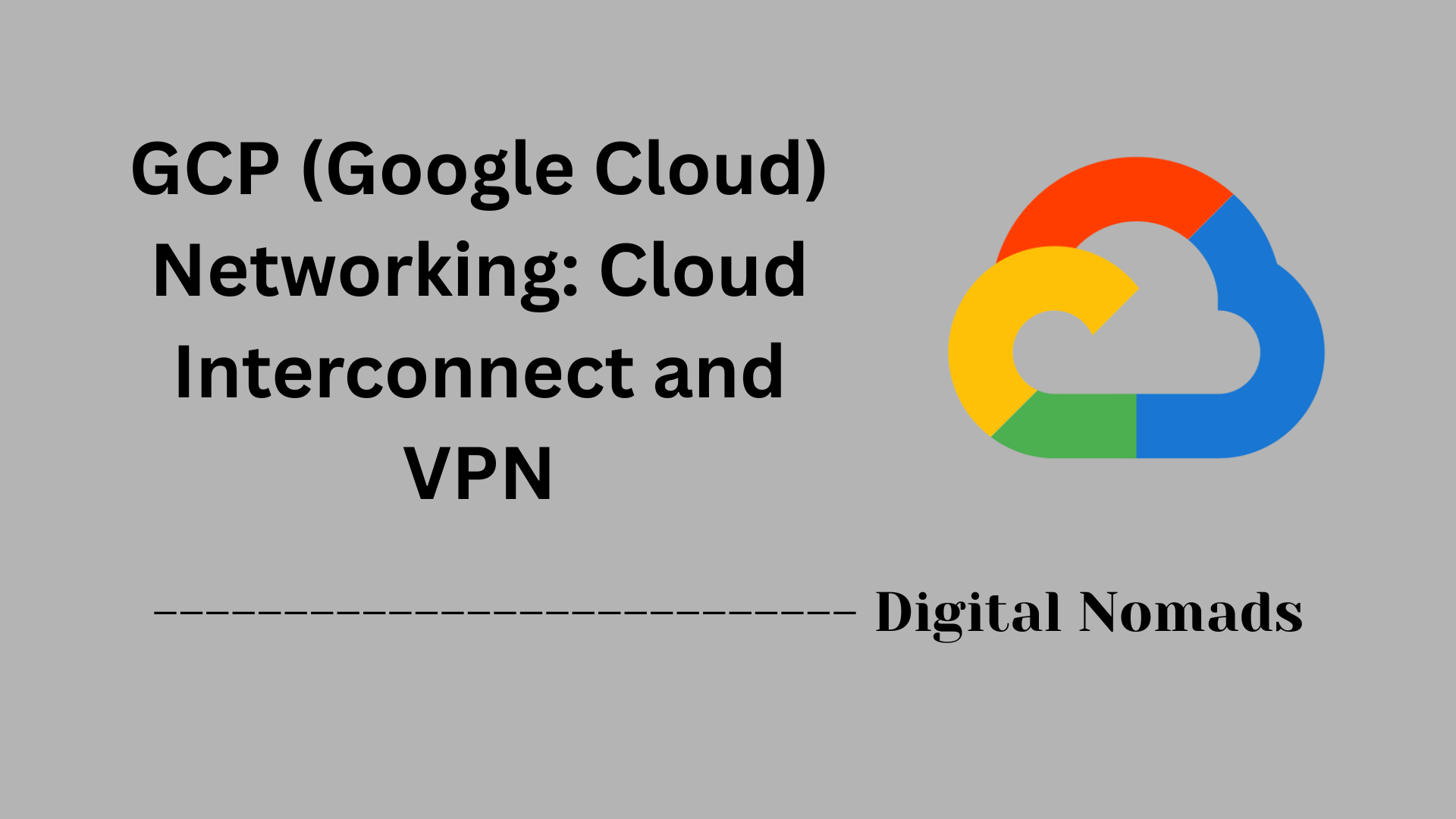Table of Contents
- Overview
- Internal IP Addresses
- External IP Addresses
- Comparing Internal vs. External IP Addresses
- Common Operations
- Best Practices
- Useful Commands
- Conclusion
Overview: GCP Networking – External and Internal IP Addresses
What Is It?
Google Cloud Platform (GCP) networking uses external and internal IP addresses to enable communication within cloud environments and with the outside world. These addresses are fundamental identifiers assigned to resources like virtual machines (VMs), databases, and load balancers. Understanding these IP types is essential to securely and efficiently design, deploy, and manage applications and services in the cloud.
- Internal IP addresses are used for private communication between resources within the same Virtual Private Cloud (VPC) network.
- External IP addresses are used to allow cloud resources to connect to or be reached from the internet.
Why Do You Need to Know About It?
- Security: Incorrect IP assignment can expose critical resources to the public internet, increasing security risks. Knowing how to use internal and external IP addresses helps you safeguard sensitive workloads.
- Cost Management: Static external IPs may incur charges, even if left unused. Proper management prevents unnecessary costs.
- Reliability: Assigning the right type of IP ensures your services are accessible to the right users without interruptions, minimizing downtime and misconfigurations.
- Compliance: Some industries require strict control over what resources are publicly accessible, making careful IP management crucial.
How Does It Work?
GCP enables network connectivity by assigning:
- Internal IP Addresses:
These are selected from private address ranges and are only reachable within your VPC or across connected networks (like peered VPCs or hybrid on-premises setups). They are not accessible from the internet and are ideal for backend services, internal databases, and service-to-service communication. - External IP Addresses:
These are globally unique and allow your resources to communicate with the internet. You can assign them either automatically (ephemeral) or reserve a specific address (static). External IPs are essential for public-facing services like web servers, public APIs, and remote management.
In everyday operations, GCP gives you control over how you assign, reserve, promote, or release these IPs. This flexibility allows for secure and scalable cloud architectures. By understanding how internal and external IP addresses are managed, you can design efficient networks, enforce strong access controls, and support both private and internet-facing workloads with confidence.
Internal IP Addresses
In Google Cloud Platform (GCP) networking, internal IP addresses are private IPs used for communication within a Virtual Private Cloud (VPC) and between resources connected to the same network. They provide a secure means for instances and services to talk to each other without exposing those resources to the public internet.
- Scope: Internal IPs are only accessible within their VPC or connected VPC networks. They are not routable from the internet, ensuring internal traffic remains isolated.
- Assignment: These addresses can be assigned ephemerally (automatically when a VM is created and released when deleted) or as static (reserved and persistently assigned to resources).
- Address Range: GCP uses private ranges defined by RFC 1918, such as 10.0.0.0/8, 172.16.0.0/12, and 192.168.0.0/16, for internal IP assignments.
-
Typical Use Cases:
- Communication between VM instances on the same VPC
- Connecting application servers to internal databases
- Enabling secure backend services that shouldn’t be accessible from the public internet
- Private communication for hybrid cloud architectures using Cloud VPN or Interconnect
-
Types of Internal IPs:
- Ephemeral Internal IP: Temporarily assigned at VM creation and automatically released when the VM is deleted or stopped.
- Static Internal IP: Reserved and persistently assigned to a VM or network interface, surviving restarts and re-attachments.
-
Management Tips:
- Use static internal IPs for workloads requiring stable internal addressing, like databases or fixed backend services.
- Plan your VPC subnets and address ranges to avoid overlaps, especially for large or growing networks.
- Restrict usage of internal IP addresses to only required resources to improve security and network hygiene.
Managing internal IP addresses efficiently helps maintain a secure and organized cloud environment while enabling scalable internal communication between services.
External IP Addresses
External IP addresses in Google Cloud Platform (GCP) allow your resources—such as virtual machines (VMs) and load balancers—to communicate with the internet and other external networks. Assigning an external IP enables cloud services to be accessible from outside your private network.
- Scope: External IPs are globally routable and can be reached from anywhere on the public internet, subject to network and firewall rules.
-
Assignment:
- Ephemeral External IP: Temporarily assigned to resources at creation. The address may change if the resource is stopped or deleted, and is automatically released when the instance is removed.
- Static External IP: Reserved to persistently provide the same IP address to a resource, regardless of restarts or re-attachments. Useful for DNS mappings and predictable endpoints.
-
Typical Use Cases:
- Hosting web applications, REST APIs, or other public-facing services on GCP VMs or load balancers
- Remote access to virtual machines via SSH or RDP
- Allowing external systems to connect with GCP-hosted backend services
-
Types of External IPs:
- IPv4 and IPv6: GCP supports both Internet Protocol versions. Choose IPv6 if required for modern, scalable workloads.
- Regional and Global IPs: Regional IPs are tied to a specific GCP region, while global IPs can be used by resources (like global load balancers) accessible from multiple regions.
-
Management Tips:
- Assign static IPs to services that require a consistent address for connectivity or DNS mapping.
- Regularly review and release unused static external IPs to avoid unnecessary charges.
- Limit granting external IPs only to essential resources to reduce attack surface and potential exposure.
- Use firewall rules to restrict which traffic can reach resources exposed by external IPs.
Careful management of external IP addresses helps control costs, improves security, and ensures reliable access to cloud services in your GCP environment.
Comparing Internal vs. External IP Addresses
Understanding the distinction between internal and external IP addresses in Google Cloud is key for architecting secure and effective network environments. Both play important roles but serve different purposes and have different scopes of reachability.
| Characteristic | Internal IP Address | External IP Address |
|---|---|---|
| Visibility | Accessible only within the same VPC or peered networks | Reachable from the public internet |
| Address Range | Uses private ranges (RFC 1918), like 10.0.0.0/8, 172.16.0.0/12 | Globally unique, public IP ranges |
| Common Use Cases | VM-to-VM communication, internal databases, backend services | Web servers, public APIs, administrative access (SSH/RDP) |
| Assignment Types | Ephemeral (auto-assigned) or Static (reserved) | Ephemeral (auto-assigned) or Static (reserved) |
| Security | Not routable from the internet, isolates internal traffic | Exposed to internet, requires strict security controls |
| Charges | No charge for assignment within VPC | Charges may apply, especially for unused static IPs |
| Persistence | Static IPs persist through VM restarts; ephemeral IPs do not | Same: static persists, ephemeral can change on restart |
-
When to use Internal IPs:
- For communication that does not need internet exposure
- Improves security and reduces attack surface
- Reduces data transfer costs within your Google Cloud environment
-
When to use External IPs:
- For services that must be accessed directly from outside your VPC
- When clients or systems on the internet need to reach your GCP resources
- For remote management, web hosting, and publishing APIs to public consumers
Select the right type of IP address for each scenario to balance access needs, security, and costs within your Google Cloud networking environment.
Common Operations
Managing IP addresses in Google Cloud Platform (GCP) involves a few core operations that help ensure your resources remain accessible and secure. Here’s a step-by-step overview of the most common operations for handling both internal and external IPs:
-
Reserving a Static External IP Address:
- Go to the VPC Network → External IP addresses section in the Google Cloud Console.
- Click Reserve static address.
- Specify a name, select the network tier, and choose the region or global scope as needed.
- Click Reserve to create and reserve your new static external IP address.
-
Assigning a Static Internal IP Address:
- While creating or editing a VM instance, go to the Network interfaces section.
- Click Edit next to the desired interface.
- Set the Internal IP to Static and provide a name or accept the auto-assigned value.
- Save and continue with your VM setup or update.
-
Listing Addresses Assigned to VMs:
- Use the Cloud Console or the following
gcloudCLI command: -
gcloud compute instances list - This will display all VM instances along with their internal and external IP addresses.
- Use the Cloud Console or the following
-
Promoting an Ephemeral IP to Static:
- Locate the assigned external ephemeral IP in the External IP addresses section.
- Click Promote to static to reserve and make the IP persistent for your resource.
-
Releasing an Unused Static IP Address:
- Go to the VPC Network → External IP addresses or Internal IP addresses page.
- Locate the static IP that's not in use.
- Click Release to free up the address and avoid unnecessary charges.
Performing these common operations helps maintain a tidy, cost-effective, and secure Google Cloud environment by ensuring IP address resources are provisioned and decommissioned as needed.
Best Practices
Implementing best practices for managing external and internal IP addresses in Google Cloud Platform (GCP) helps ensure your cloud environment is secure, reliable, and cost-effective. Follow these proven approaches for optimal results:
-
Minimize Use of External IPs:
- Assign external IP addresses only to resources that must be accessible from the internet.
- Reduce attack surface by keeping most services internal to the Virtual Private Cloud (VPC).
-
Leverage Internal IPs for Secure Communication:
- Promote communication between services using internal IP addresses whenever possible.
- Ensure sensitive databases and backend systems are accessible only through internal IPs.
-
Reserve Static IPs Where Consistency is Needed:
- Assign static IP addresses to workloads that require consistent endpoints (e.g., databases, APIs, or systems with DNS records pointing to them).
- Avoid using ephemeral IPs for resources that cannot tolerate address changes.
-
Regularly Audit and Clean Up Unused IPs:
- Review assigned static external and internal IPs to ensure they are in active use.
- Release IP addresses that are no longer needed to prevent unnecessary charges and improve security.
-
Implement Strict Firewall Rules:
- Restrict access to resources using tightly scoped firewall rules for both internal and external IP ranges.
- Allow only required traffic and deny unnecessary connections by default.
-
Plan VPC Subnets Thoughtfully:
- Allocate subnet ranges to avoid future overlaps, especially when using hybrid or multi-cloud architectures.
- Document subnet allocations and reserved ranges for better governance.
-
Monitor Network Traffic:
- Use monitoring and logging tools to track network traffic to and from both internal and external IPs.
- Set alerts for suspicious spikes or anomalies in traffic patterns.
By following these best practices, you can manage GCP IP addresses in a way that supports security, efficiency, and scalability throughout your cloud infrastructure.
Useful Commands
Managing IP addresses in Google Cloud Platform (GCP) is much easier and faster with the gcloud command-line interface. Here are some essential commands that help you reserve, list, and release both internal and external IP addresses:
-
Reserve a Static External IP Address:
gcloud compute addresses create my-static-ip --region=us-central1This reserves a new static IP in the specified region to be assigned to a VM or other resources.
-
Reserve a Static Internal IP Address:
gcloud compute addresses create my-static-internal-ip \ --region=us-central1 \ --subnet=my-subnet \ --addresses=10.0.0.50 \ --purpose=GCE_ENDPOINTThis command reserves a static internal IP address within a given subnet and region.
-
List Internal and External IPs for All Instances:
gcloud compute instances listThis displays a table of all VM instances in your project, including their internal and external IP addresses.
-
Promote an Ephemeral External IP to Static:
gcloud compute addresses create my-promoted-ip \ --addresses=\ --region=us-central1 Reserves a static address from an ephemeral IP currently assigned to your resource.
-
Release a Static External IP Address:
gcloud compute addresses delete my-static-ip --region=us-central1Deletes and releases the specified static external IP address so it’s no longer reserved or billed.
These commands help you automate and streamline your GCP networking tasks, making IP address management efficient and error-free.
Conclusion
Throughout this blog post, we’ve taken a deep dive into how Google Cloud Platform (GCP) manages internal and external IP addresses—a fundamental aspect of building, securing, and scaling your cloud infrastructure.
Here's what we covered:
- Internal IP Addresses are ideal for private communication between services and are confined to your Virtual Private Cloud (VPC). They're secure, cost-effective, and essential for backend systems like databases and internal apps.
- External IP Addresses provide public access to your resources and are typically used for web servers, APIs, or remote access needs. While powerful, they should be used sparingly and with strong firewall rules.
- We looked at a side-by-side comparison of internal vs. external IPs, clarifying when and why to use each based on visibility, purpose, and security.
- The common operations section walked you through reserving, assigning, and releasing IP addresses—proactive steps that help avoid downtime and unnecessary charges.
- Adopting best practices like using static IPs where appropriate, freeing unused addresses, and limiting external exposure helps you keep your cloud network secure, clean, and efficient.
- Finally, a handy list of useful
gcloudcommands empowers you to manage your IP addresses quickly from the CLI.
Understanding and managing IP addresses might sound basic, but it’s at the core of any reliable and secure cloud architecture. Whether you’re deploying your first VM or optimizing a multi-region network, these principles are key to success in GCP.
Thanks for reading! 😊
Feel free to share this with your team, bookmark it for future reference, and happy cloud building! 🚀




